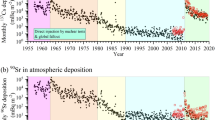The emissions from Russian NPP in 2011–2017, which, on the whole, taking the specifics of nuclear reactors into consideration, correspond to the global emissions, are analyzed. The public irradiation dose due to NPP emissions is estimated to be 0.01–0.1% of the dose due to natural background radiation. It is shown that the location of fixed stations for monitoring the radioactivity of the surface air layer and atmospheric fallout near NPP meets the requirements of Russian regulatory documents and IAEA recommendations. The volume activity of 137Cs, 60Co, and other technogenic radionuclides in the surface air layer in the NPP observation zones are 104–108 times lower than the volumetric activity admissible for the public. To improve the monitoring of the radiation conditions, the 14C and 3H present in the emissions from NPP must be monitored, and collection of atmospheric fallout at fixed observation stations near NPP must be more efficient.
Similar content being viewed by others
References
Radiation Conditions in Russia and Neighboring States in 2011–2017. Rosgidromet Yearbooks, NPO Taifun, Obninsk.
I. I. Kryshev and E. P. Ryazantsev, Environmental Safety of the Nuclear Power System in Russia, IzdAT, Moscow (2010), 2nd ed.
I. I. Linge and I. I. Kryshev (eds.), Radioecological Conditions in the Vicinity of Rosatom Enterprises, SAM Poligrafist, Moscow (2015).
Exposures of the Public and Workers from Various Sources of Radiation, UNSCEAR 2016 Rep. to the General Assembly with Scientifi c Annexes, UNSCEAR, New York (2017), pp. 135–240.
V. P. Rublevskii, V. N. Yatsenko, and E. G. Chanyshev, The Role of Carbon-14 in Technogenic Irradiation of Humans, IzdAT, Moscow (2004).
Methodology MT 1.2.1.15.1176–2016, Development and Establishment of Standards for Maximum Permissible Atmospheric Emissions of Radioactive Substances from Nuclear Power Plants, Rosenergoatom Concern, Moscow (2016).
RD 52.18.826–2015, Instructions for Hydrometeorological Plants and Stations, Issue No. 12, Observations of Radioactive Contamination of Components of the Environmental, NPO Taifun, Obninsk (2015).
Programmes and Systems for Source and Environmental Radiation Monitoring, Saf. Rep. Ser. No. 64, IAEA, Vienna (2010).
Recommendations R 52.18.863–2017, Procedure for Determining the Radiation Background by Monitoring of the Radiation Conditions, NPO Taifun, Obninsk (2017).
MU 2.6.5.010–2016, Validation of the Limits and Operating Conditions of the Sanitary-Protection Zones and Zones of Observation of Radiation Facilities, Rostekhnadzor, Moscow (2016).
Analysis of Cancer Risks in Populations Near Nuclear Facilities: Phase I, National Academic Press (US), Washington (2012).
Author information
Authors and Affiliations
Corresponding author
Additional information
Translated from Atomnaya Énergiya, Vol. 126, No. 4, pp. 228–234, April, 2019.
Rights and permissions
About this article
Cite this article
Kryshev, I.I., Bulgakov, V.G., Kryshev, A.I. et al. Radioactivity Monitoring of the Surface Air Layer and Atmospheric Fallout Near NPP. At Energy 126, 264–271 (2019). https://doi.org/10.1007/s10512-019-00548-8
Received:
Published:
Issue Date:
DOI: https://doi.org/10.1007/s10512-019-00548-8




